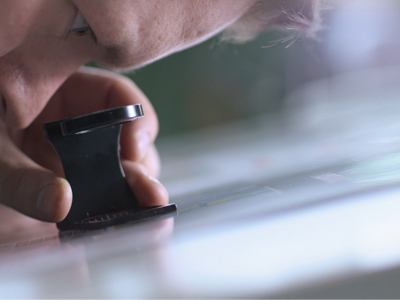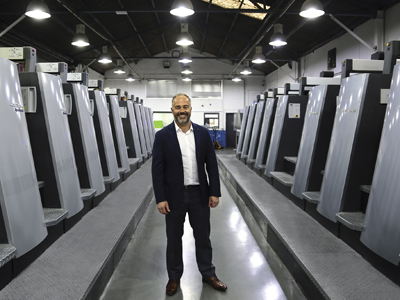Aron Priest of Solopress has expanded the business into two factories with a third being renovated this year
Trade print isn’t just about covering overflow or one-off specialist work. There’s a huge resource available to you that can extend your business in new directions, as Michael Walker found out.
Printers have always farmed bits of work out to each other. Some did mono while others had four-colour. Some had great repro while others had a better bindery. Sometimes you had the gear in-house but were simply too busy to do it all in time so you went outside for help.
Trade printing isn’t a new idea at all, but what’s changed recently is the scale on which it’s done, the range of services it can offer and the ways in which it can proactively help you expand your own service offering and so grow your business.
Why go outside?
Increasing your capacity is one of the most obvious reasons to look to the trade printer. And there is some serious capacity out there; OnlinePrinters started as a family firm in 1984 and now has 113 litho printing units across four plants in Germany, and 16 national websites selling over 1500 products, available in over 10 million configurations. Patrick Piecha, the company’s head of press and PR, says, ‘It’s not a print shop, it’s an e-commerce company,’ and likens its approach to that of Amazon, saying that ‘people want the best products, price and timing – quality is standard, everybody expects it’.
Another continental Europe-based print behemoth is Flyeralarm, which according to UK managing director Keith Hanson, is the largest commercial online printer in Europe, turning over €230 million. Flyeralarm has offered e-commerce since 2002, and now operates in 15 countries, serving 1.5 million customers from a menu of three million product permutations. It operates eight production sites and is home to 23 of the world’s 46 Heidelberg Speedmaster XL162 A0 presses.
Most digital print shops never get orders for the kind of quantity that beasts like these can print, but you don’t need to be printing leaflets for national referenda to benefit, as the ability to gang jobs means that far humbler print runs can be accommodated at price points that would normally mean “digital only”.
‘Small digital print companies might send out for litho work, to cover for a breakdown or to meet higher-than-usual quality requirements,’ says Gary White, managing director of Belfast-based Northside Graphics which runs tradedigitalprint.co.uk and has a fleet of HP Indigos to service digital print orders from beyond Northern Ireland – but outsources litho work itself. Peter Bradley, managing director at “99% trade” Quinns the Printers, reports a similar customer profile: ‘A lot of our customers have digital capabilities already so they outsource their litho but do their own digital.’
Sourcing specialities
Another reason to outsource is to get access to special materials or services that it’s not practical to buy or offer yourself. This might be the combination of digitally-printed covers on litho book blocks for versioned booklets or brochures for trade fairs, for example, which is one of the things that Online Printers offers, or it might be an unusually wide range of substrates: ‘Someone might want to print just 20 sheets on a Sirio metallic paper, but don’t want to buy a whole pack,’ explains Gary White, who says that keeping a very wide range of substrates is one of his company’s USPs.

Good quality might be “standard” at Online Printers but it still requires checking to make sure
Binding and finishing capabilities are also logical specialisations to outsource. Northside offers PUR perfect binding and saddle-stitching so that it can offer runs of one or two bound books or brochures for samples and then print longer runs on the same press for consistency. Very short run booklet-making via CP Bourg equipment is also offered by Southend on Sea-based Solopress, which has just been acquired by Online Printers. Conversely, Jack Wilmott, brand manager at South Yorkshire Route One Print, which is a fast growing trade-only printer that has made it into the Fast Track 100 for the last two years, says, ‘Some specialist finishers buy the print from us, then add their own embossing or foiling.’
In addition to hot foil stamping and specialist coatings, Flyeralarm offers textile printing onto garments such as jackets or polo shirts. Keith Hanson says, ‘A hotel could buy everything it needs from us, from door hangers to name badges and uniforms.’ Most of the textile printing at Flyeralarm is done by conventional means, but the company is also doing some digital print on a Kornit Allegro machine and offering a range of textiles including organic silk.

Stuart Maclaren of Your Print Partner supplies digitally printed textiles for events such as Cancer Research’s Race for Life
All-digital textile print is the preserve of Your Print Partner. Starting out as a textile print broker shortly before the 2012 Olympics, founder Stuart Maclaren has come from operating from his kitchen table to having the biggest Mimaki installation in the UK, with a fleet of direct-to-textile dye sublimation printers responsible for a turnover of £3.5 million. ‘We’re taking 350 orders a day, and producing 4000 linear metres, about 12,000m², a week,’ Mr Maclaren reports.
Pretty well all of that is trade work, too, mostly for signage customers, and the print is supplemented by complementary products such as a novel modular tubular frame system manufactured specifically for Your Print Partner, which enables stretch fabrics to be used in signage and other applications.
Many trade printers are offering wide-format print for more typical applications, such as PoS and signage. Tradeprint.co.uk, formerly Expaprint and now part of Cimpress, has an HP Scitex 10000, which it uses mostly for rigid substrates and some banner work, for example; while Solopress has run a pair of Jetrix RX3200 roll-fed printers for less than two years and managing director Aron Priest is already considering replacing them to achieve higher throughput.
Customer experience is king
Pricing is extremely competitive in trade print, ‘especially in UK, where prices have dropped 10 to 15% this year and most PSPs will get five or six quotes,’ says Flyeralarm’s Keith Hanson. So if there’s not much difference on price, how do you choose?
‘Good online trade printing sites must be about making saying “yes” simple to do,’ offers Gary Peeling, CEO of Precision Printing which also runs the Where The Trade Buys site. ‘Early providers would present limited choices and discount heavily to encourage their use,’ he expands, ‘but more useful are the smart quoting tools that allow the user to select any size, any material – your job, your way.’
A good customer experience may start with the specification and pricing of the job but should run right through the transaction. Jack Wilmott at Route One accepts that customers are increasingly price-sensitive but adds, ‘There are important non-price elements too – reliability and trust. The acid test is when it goes wrong; we have to own up to the mistake and rectify it ASAP”. Keith Hanson points out that quality ‘extends to finishing, dispatch and delivery’ too; Aron Priest at Solopress shows how smaller print jobs are shrink-wrapped and sent out in Amazon-style boxes to ensure safe delivery, while Online Printers puts a re-order button on its website to simplify repeat business.

Simon Cooper of Tradeprint.co.uk says that making the customer experience “second to none” is key
Sometimes problems are of the customer’s making. Although Quinn’s Peter Bradley speaks for many when he says, ‘We like working with printing companies, they usually know their stuff,’ things can still go wrong with job submission. Some trade printers limit the types of files they’ll accept; others will email if they hit a problem. Tradeprint’s managing director Simon Cooper explains that as well as accepting file uploads via website, ftp or services such as WeTransfer, ‘we offer three levels of file service – Assist, Check and Just Print to make it easier for customers to place orders.’
Customer support can range from call-centre type handling operations using Live Chat features, which Solopress has used to some effect in cross-selling and up-selling, to providing dedicated account managers or customer service teams, to manual email handling at Your Print Partner, where the complexities of textile printing and finishing make automated handling impossible.
Faster, better – and no printing required?
Speed is of course another area where trade printers try to outdo each other. Route One has recently introduced a same-day dispatch service for selected popular products; Online Printers offers same day printing and express delivery, while Solopress will get you up to 2000 copies of a bound job next day if you order before 2pm.
Then there is customer support that helps print re-sellers to expand their horizons. This ranges from simple unbranded swatches and samples to educational materials in the form of white papers, guides, tightly targeted e-books such as those from Route One (see last issue, p20, for an example), promotions and live events like the eponymous Tradeprint Live series running around the UK this month.
Beyond that, there’s even the Uber-like model where ‘printers’ don’t actually do any printing but just sell print that they source elsewhere. Where The Trade Buys’ Gary Peeling gives an example: ‘Our pop-up banner costs £25 including delivery, and takes three minutes to order. Sell it for £45 and you will have a 40% margin after covering the admin cost.’
Gary White at Northside sees this appealing to newer entrants into the business who ‘may not have the desire to own the equipment or do everything themselves. Our pitch is “you can have your own Indigo and it won’t cost you a penny”,’ he says. Jack Wilmott at Route One suggests that ‘copyshops are selling their gear and designers are getting more involved, offering a design plus print “2 for 1” deal.’
Aron Priest’s advice to a wide-format printer who recently acquired a GTO press was even more blunt: ‘Sell the press, do your large format print in-house and sell the rest on the side.’
—
Read the full article here





